Reptile Biodiversity and Vulnerability in Bolivia’s Beni Department: Informing Conservation Priorities in a Neglected Frontier
Abstract
:1. Introduction
2. Materials and Methods
3. Results
4. Discussion
5. Conclusions
Supplementary Materials
Author Contributions
Funding
Institutional Review Board Statement
Data Availability Statement
Acknowledgments
Conflicts of Interest
References
- INE. Boletín Estadístico Producto Interno Bruto al Segundo Trimestre. 2020. Available online: https://www.ine.gob.bo/index.php/publicaciones/boletin-estadistico-producto-interno-bruto-alsegundo-trimestre-2020/ (accessed on 15 December 2023).
- Embert, D. Distribution, Diversity, and Conservation Status of Bolivian Reptiles. Ph.D. Dissertation, Rheinischen Friedrichs-Wilhelms-Universitat Bonn, Bonn, Germany, 2007; p. 429. [Google Scholar]
- Aliaga-Rossel, E. Distribution and abundance of the river dolphin (Inia geoffrensis) in the Tijamuchi River, Beni, Bolivia. Aquat. Mamm. 2002, 28, 312–323. [Google Scholar]
- Larrea-Alcázar, D.M.; Embert, D.; Aguirre, L.F.; Ríos-Uzeda, B.; Quintanilla, M.; Vargas, A. Spatial patterns of biological diversity in a neotropical lowland savanna of northeastern Bolivia. Biodivers. Conserv. 2011, 20, 1167–1182. [Google Scholar]
- Erickson, C.L. The domesticated landscapes of the Bolivian Amazon. In Time and Complexity in Historical Ecology: Studies in the Neotropical Lowlands; Balée, W.L., Erickson, C.L., Eds.; Columbia University Press: New York, NY, USA, 2006; pp. 235–278. [Google Scholar]
- Walker, J.H. Pre-Columbian ring ditches along the Yacuma and Rapulo Rivers, Beni, Bolivia: A preliminary review. J. Field Archaeol. 2008, 33, 413–427. [Google Scholar] [CrossRef]
- Erickson, C.L. The transformation of environment into landscape: The historical ecology of monumental earthwork construction in the Bolivian Amazon. Diversity 2010, 2, 618–652. [Google Scholar] [CrossRef]
- Beck, H.E.; Zimmermann, N.E.; McVicar, T.R.; Vergopolan, N.; Berg, A.; Wood, E.F. Present and future Köppen-Geiger climate classification maps at 1-km resolution. Sci. Data 2018, 5, 180214. [Google Scholar] [CrossRef] [PubMed]
- Navarro, G. Vegetación y Unidades Biogeográficas. In Geografía Ecológica de Beni. Vegetación y Ambientes Acuáticos; Navarro, G., Maldonado, M., Eds.; Editorial Centro de Ecología Difusión Simón I. Patiño: Cochabamba, Bolivia, 2002; pp. 1–500. [Google Scholar]
- Navarro, G. Clasificación de la Vegetación de Bolivia; Centro de Ecología Difusión Simón I. Patiño: Santa Cruz, Bolivia, 2011. [Google Scholar]
- Navarro, G.; Ferreira, W. Biogeografía de Bolivia. In Libro Rojo de Parientes Silvestres de Cultivos de Bolivia; Moraes, M., Mostacedo, B., Altamirano, S., Eds.; Viceministerio de Medio Ambiente, Biodiversidad y Cambio Climático (VMABCC), Plural Editores: La Paz, Bolivia, 2009; pp. 23–39. [Google Scholar]
- Myster, R.W. The Physical Structure of Forests in the Amazon Basin: A Review. Bot. Rev. 2016, 82, 407–427. [Google Scholar] [CrossRef]
- Bredin, Y.K.; Hawes, J.E.; Peres, C.A.; Haugaasen, T. Structure and composition of Terra Firme and Seasonally Flooded Várzea Forests in the Western Brazilian Amazon. Forests 2020, 11, 1361. [Google Scholar] [CrossRef]
- Moraes, R. Flora de Palmeras de Bolivia, 2nd ed.; Universidad Mayor de San Andrés: La Paz, Bolivia, 2020. [Google Scholar]
- Ibisch, P.L.; Beck, S.G.; Gerkmann, B.; Carretero, A. Ecoregiones y ecosistemas. In Biodiversidad: La Riqueza de Bolivia; Ibisch, P.L., Me, G., Eds.; Editorial FAN: Santa Cruz de la Sierra, Bolivia, 2003; pp. 47–88. [Google Scholar]
- Langstroth, R.P. Forest Islands in an Amazonian Savanna of Northeastern Bolivia. Ph.D. Dissertation, University of Wisconsin, Madison, WI, USA, 1996; p. 452. [Google Scholar]
- Langstroth, R.P. Biogeography of the Llanos de Moxos: Natural and anthropogenic determinants. Geogr. Helv. 2011, 66, 183–192. [Google Scholar] [CrossRef]
- Haase, R.; Beck, G. Structure and composition of savanna vegetation in northern Bolivia: A preliminary report. Brittonia 1989, 41, 80–100. [Google Scholar] [CrossRef]
- Eversole, C.B.; Powell, R.L.; Lizarro, D.; Moreno, F.; Vaca, G.C.; Aparicio, J.; Crocker, A.V. Introduction of a novel natural history collection: A model for global scientific collaboration and enhancement of biodiversity infrastructure with a focus on developing countries. Biodivers. Conserv. 2019, 28, 1921–1931. [Google Scholar] [CrossRef]
- Steinberg, P. Environmental Leadership in Developing Countries: Transnational Relations of Biodiversity Policy in Costa Rica and Bolivia; MIT Press: Cambridge, MA, USA, 2001. [Google Scholar]
- Moravec, J.; Aparicio, J. Notes on the herpetofauna of Nacebe (Provincia Abuna, Departamento Pando, Bolivia). Časopis Národního Muz. Řada Přírodovědná 2004, 173, 13–28. [Google Scholar]
- Eversole, C.B.; Powell, R.L.; Lizarro, D.; Crocker, A.V.; Vaca, G.C.; Quintana, P.L. Herpetofauna of the Reserva de la Biósfera Estación Biológica del Beni and the Chimane Reserve Indigenous Territory, Bolivia. Neotrop. Biodivers. 2021, 7, 146–154. [Google Scholar] [CrossRef]
- Wilson, L.D.; Mata-Silva, V.; Johnson, J.D. A conservation reassessment of the reptiles of Mexico based on the EVS measure. Amphib. Reptile Conserv. 2013, 7, 1–47. [Google Scholar]
- Gibbons, J.W.; Scott, D.E.; Ryan, T.J.; Buhlmann, K.A.; Tuberville, T.D.; Metts, B.S.; Greene, J.L.; Mills, T.; Leiden, Y.; Poppy, S.; et al. The global decline of reptiles, déja vu amphibians. BioScience 2000, 50, 653–666. [Google Scholar] [CrossRef]
- Uetz, P.; Freed, P.; Aguilar, R.; Reyes, F.; Kudera, J.; Hošek, J. The Reptile Database. 2023. Available online: http://www.reptile-database.org/ (accessed on 1 June 2024).
- Lemos-Espinal, J.A.; Smith, G.R.; Rorabaugh, J. A conservation checklist of the amphibians and reptiles of Sonora, Mexico, with updated species lists. ZooKeys 2019, 829, 131–160. [Google Scholar] [CrossRef] [PubMed]
- International Union for the Conservation of Nature (IUCN). 2022. IUCN Red List of Threatened Species. 2019. Available online: http://www.iucnredlist.org (accessed on 15 December 2023).
- Wilson, L.D.; McCranie, J.R. The conservation status of the herpetofauna of Honduras. Amphib. Reptile Conserv. 2004, 3, 6–33. [Google Scholar] [PubMed]
- R Core Team. R: A Language and Environment for Statistical Computing; R Foundation for Statistical Computing: Vienna, Austria, 2021; Available online: https://www.R-project.org/ (accessed on 15 December 2023).
- Ogle, D.H.; Doll, J.C.; Wheeler, P.; Dinno, A. FSA: Fisheries Stock Analysis. R Package Version 0.9.1. 2021. Available online: https://github.com/droglenc/FSA (accessed on 15 December 2023).
- Gardner, T.A.; Barlow, J.; Chazdon, R.; Ewers, R.M.; Harvey, C.A.; Peres, C.A.; Sodhi, N.S. Prospects for tropical forest biodiversity in a human-modified world. Ecol. Lett. 2009, 12, 561–582. [Google Scholar] [CrossRef] [PubMed]
- Rodrigues, A.S.L.; Andelman, S.J.; Bakarr, M.I.; Boitani, L.; Brooks, T.M.; Cowling, R.M.; Fishpool, L.D.C.; da Fonseca, G.A.B.; Gaston, K.J.; Hoffmann, M.; et al. Effectiveness of the global protected area network in representing species diversity. Nature 2006, 440, 221–227. [Google Scholar] [CrossRef] [PubMed]
- Mace, G.M.; Collar, N.J.; Gaston, K.J.; Hilton-Taylor, C.; Akçakaya, H.R.; Leader-Williams, N.; Stuart, S.N. Quantification of extinction risk: IUCN’s system for classifying threatened species. Conserv. Biol. 2008, 22, 1424–1442. [Google Scholar] [CrossRef]
- Beng, K.C.; Corlett, R.T. Applications of environmental DNA (eDNA) in ecology and conservation: Opportunities, challenges, and prospects. Biodivers. Conserv. 2020, 29, 2089–2121. [Google Scholar] [CrossRef]
- Tan, W.C.; Herrel, A.; Rödder, D. A global analysis of habitat fragmentation research in reptiles and amphibians: What have we done so far? Biodivers. Conserv. 2023, 32, 439–468. [Google Scholar] [CrossRef]
- Foster, R.B.; Parker, T.A., III; Gentry, A.H.; Emmons, L.H.; Chicchon, A.; Schulenberg, T.; Rodriguez, L.; Lamas, G.; Ortega, H.; Icochea, J.; et al. The Tambopata-Candamo Reserved Zone of Southeastern Peru: A Biological Assessment; Rapid Assessment Program Working Paper 6; Conservation International: Washington, DC, USA, 1994; p. 184. [Google Scholar]
- Gentry, A.H.; León, B. Tambopata region, Peru. In Centres of Plant Diversity: A Guide and Strategy for Their Conservation; Davis, S.D., Heywood, V.H., Herrera-Macbryde, O., Villa-Lobos, J., Hamilton, A.C., Eds.; WWF and IUCN: New York, NY, USA, 1997; pp. 355–359. [Google Scholar]
- Laurencio, D.; Malone, J.H. The amphibians and reptiles of Parque Nacional Carara, a transitional herpetofaunal assemblage in Costa Rica. Herpetol. Conserv. Biol. 2009, 4, 120–131. [Google Scholar]
- Köhler, J.; Price, A.H. New species of Eleutherodactylus (Anura: Leptodactylidae) from cloud forest of Bolivia. Copeia 2000, 2000, 516–520. [Google Scholar] [CrossRef]
- Reichle, S.; Embert, D. New species of Clelia (Colubridae) from the inter-Andean dry valleys of Bolivia. J. Herpetol. 2005, 39, 379–383. [Google Scholar] [CrossRef]
- Crandall, K.A.; Bininda-Emonds, O.R.P.; Mace, G.M.; Wayne, R.K. Considering evolutionary processes in conservation biology. Trends Ecol. Evol. 2000, 15, 290–295. [Google Scholar] [CrossRef] [PubMed]
- Campos-Silva, J.V.; Hawes, J.E.; Andrade, P.C.M.; Peres, C.A. Unintended multispecies co-benefits of an Amazonian community-based conservation program. Nat. Sustain. 2018, 1, 650–656. [Google Scholar] [CrossRef]
- Onyishi, I.E.; Nwonyi, S.K.; Pazda, A.; Prokop, P. Attitudes and behaviour toward snakes on the part of Igbo people in southeastern Nigeria. Sci. Total Environ. 2021, 763, 143045. [Google Scholar] [CrossRef] [PubMed]
- Fahrig, L. Effects of habitat fragmentation on biodiversity. Annu. Rev. Ecol. Evol. Syst. 2003, 34, 487–515. [Google Scholar] [CrossRef]
- Newbold, T.; Hudson, L.N.; Hill, S.L.L.; Contu, S.; Lysenko, I.; Senior, R.A.; Börger, L.; Bennett, D.J.; Choimes, A.; Collen, B.; et al. Global effects of land use on local terrestrial biodiversity. Nature 2015, 520, 45–50. [Google Scholar] [CrossRef]
- Böhm, M.; Collen, B.; Baillie, J.E.M.; Bowles, P.; Chanson, J.; Cox, N.; Hammerson, G.; Hoffmann, M.; Livingstone, S.R.; Ram, M.; et al. The conservation status of the world’s reptiles. Biol. Conserv. 2013, 157, 372–385. [Google Scholar] [CrossRef]
- Urbina-Cardona, J.N.; Loyola, R.D. Applying niche-based models to predict endangered-hylid potential distributions: Are neotropical protected areas effective enough? Trop. Conserv. Sci. 2008, 1, 417–445. [Google Scholar] [CrossRef]
- Le Saout, S.; Hoffmann, M.; Shi, Y.; Hughes, A.; Bernard, C.; Brooks, T.M.; Bertzky, B.; Butchart, S.H.M.; Stuart, S.N.; Badman, T.; et al. Protected areas and effective biodiversity conservation. Science 2013, 342, 803–805. [Google Scholar] [CrossRef]
- Cazalis, V.; Princé, K.; Mihoub, J.B.; Kelly, J.; Butchart, S.H.M.; Rodrigues, A.S.L. Effectiveness of protected areas in conserving tropical forest birds. Nat. Commun. 2020, 11, 4461. [Google Scholar] [CrossRef] [PubMed]
- Bergmann, P.J.; Russell, A.P. Systematics and biogeography of the widespread Neotropical gekkonid genus Thecadactylus (Squamata), with the new description of a new cryptic species. Zool. J. Linn. Soc. 2007, 149, 339–370. [Google Scholar] [CrossRef]
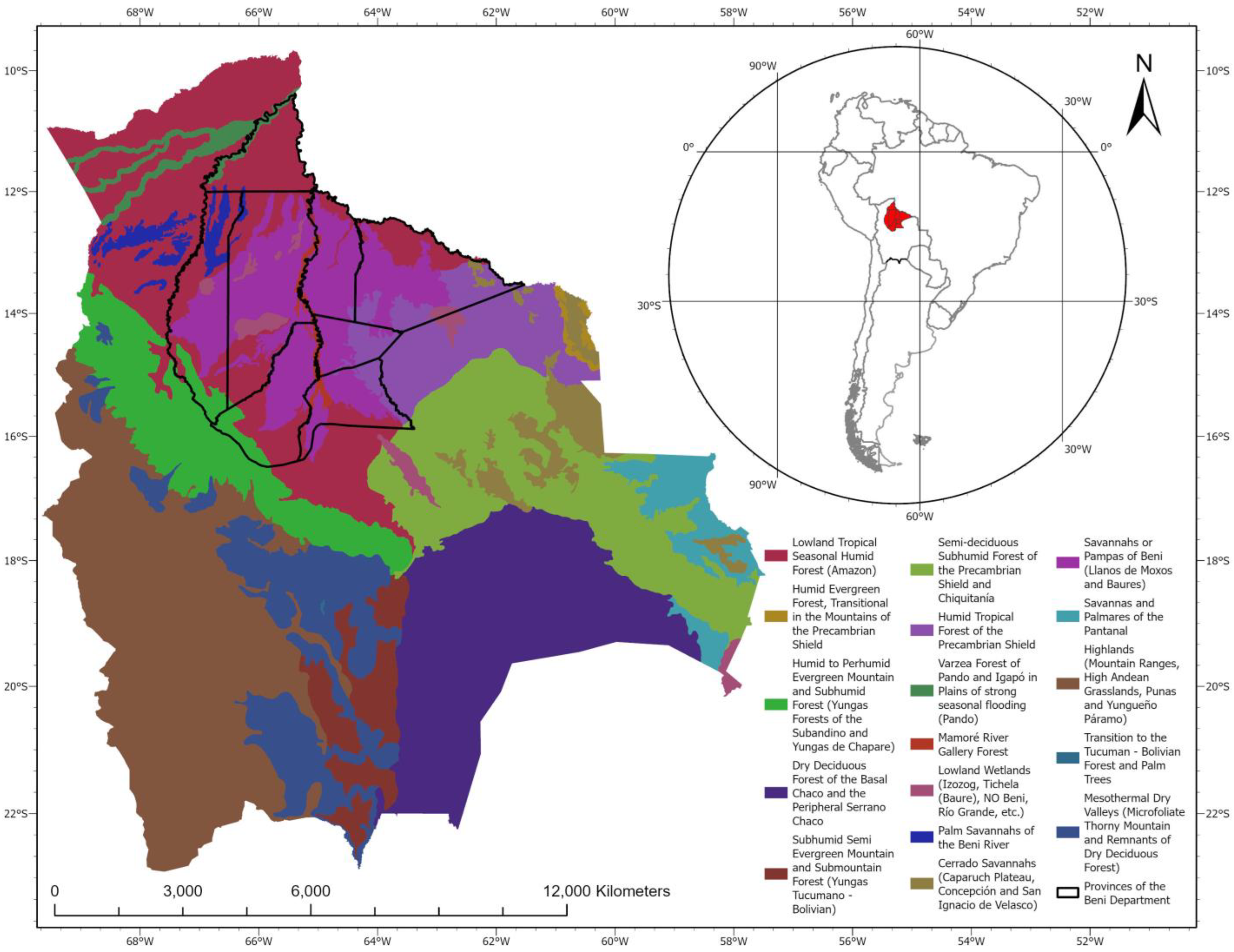

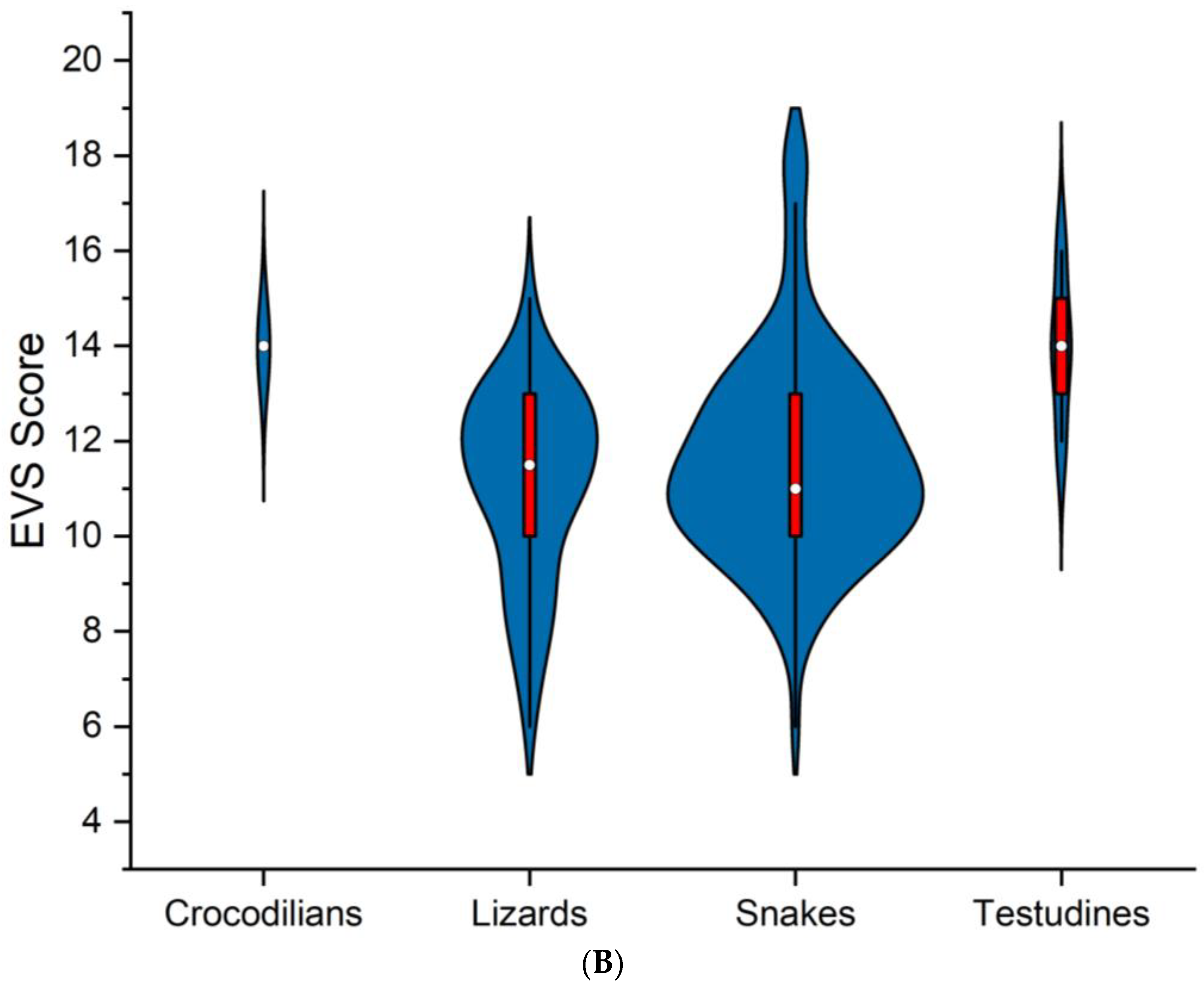
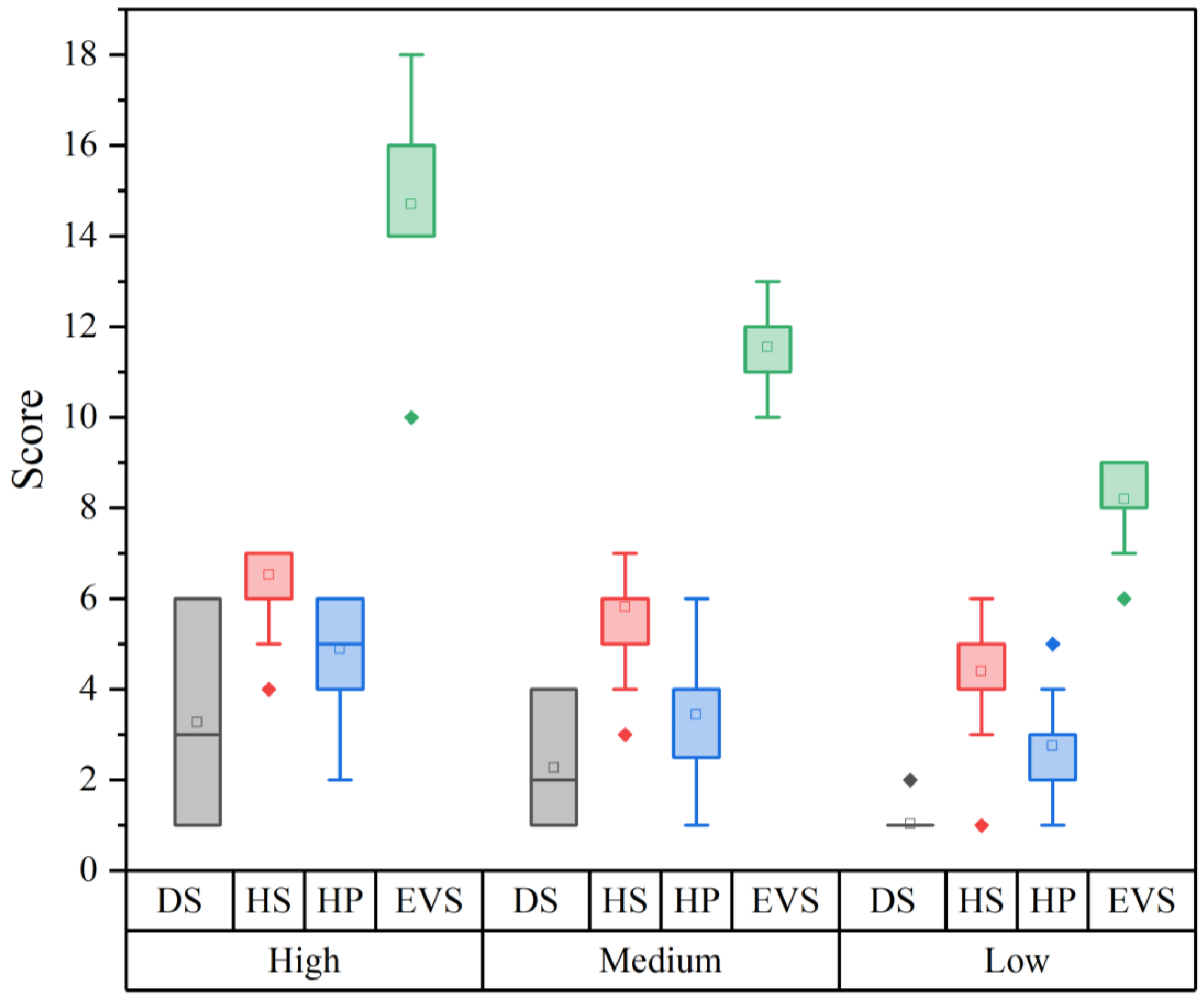
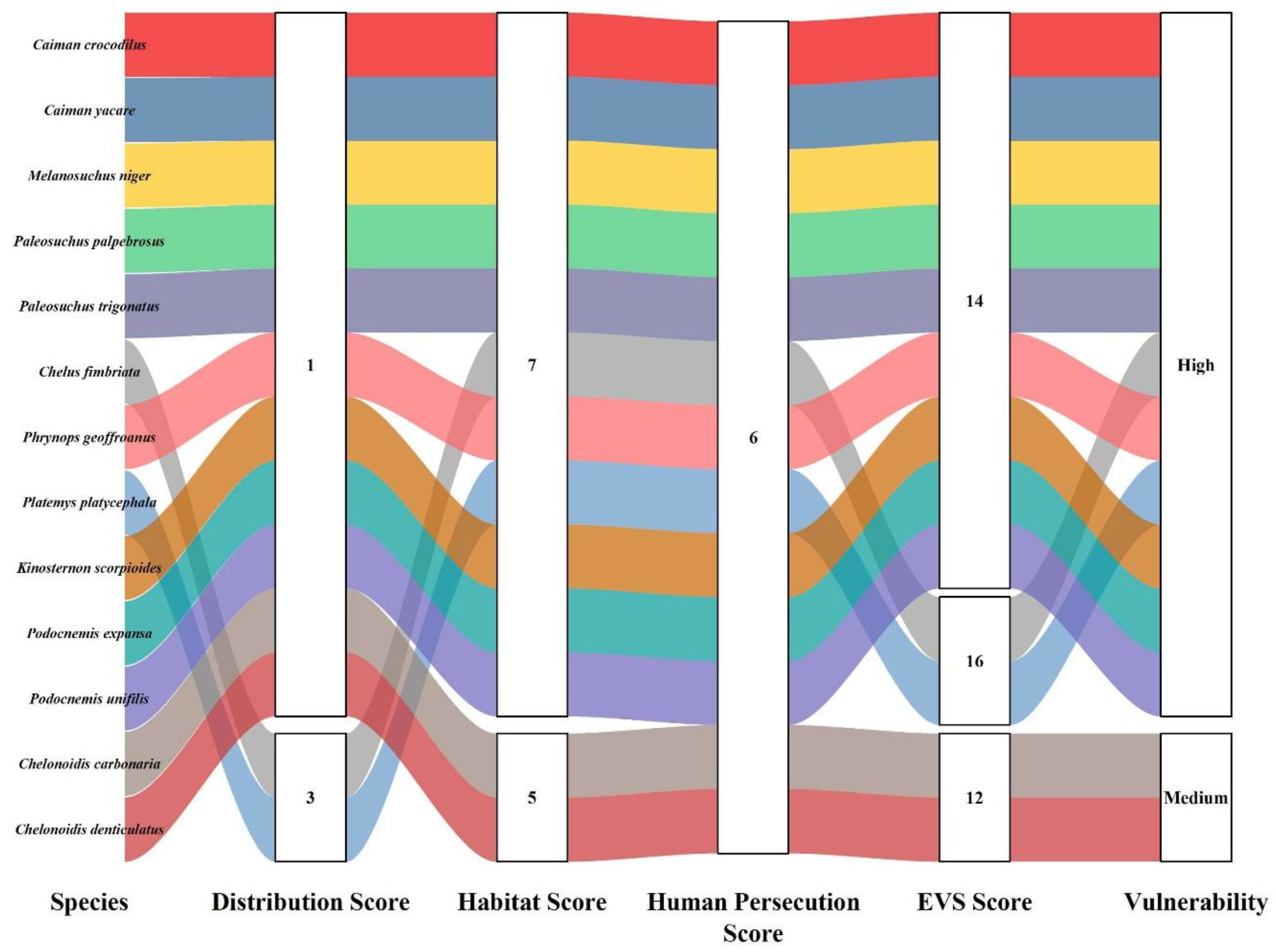
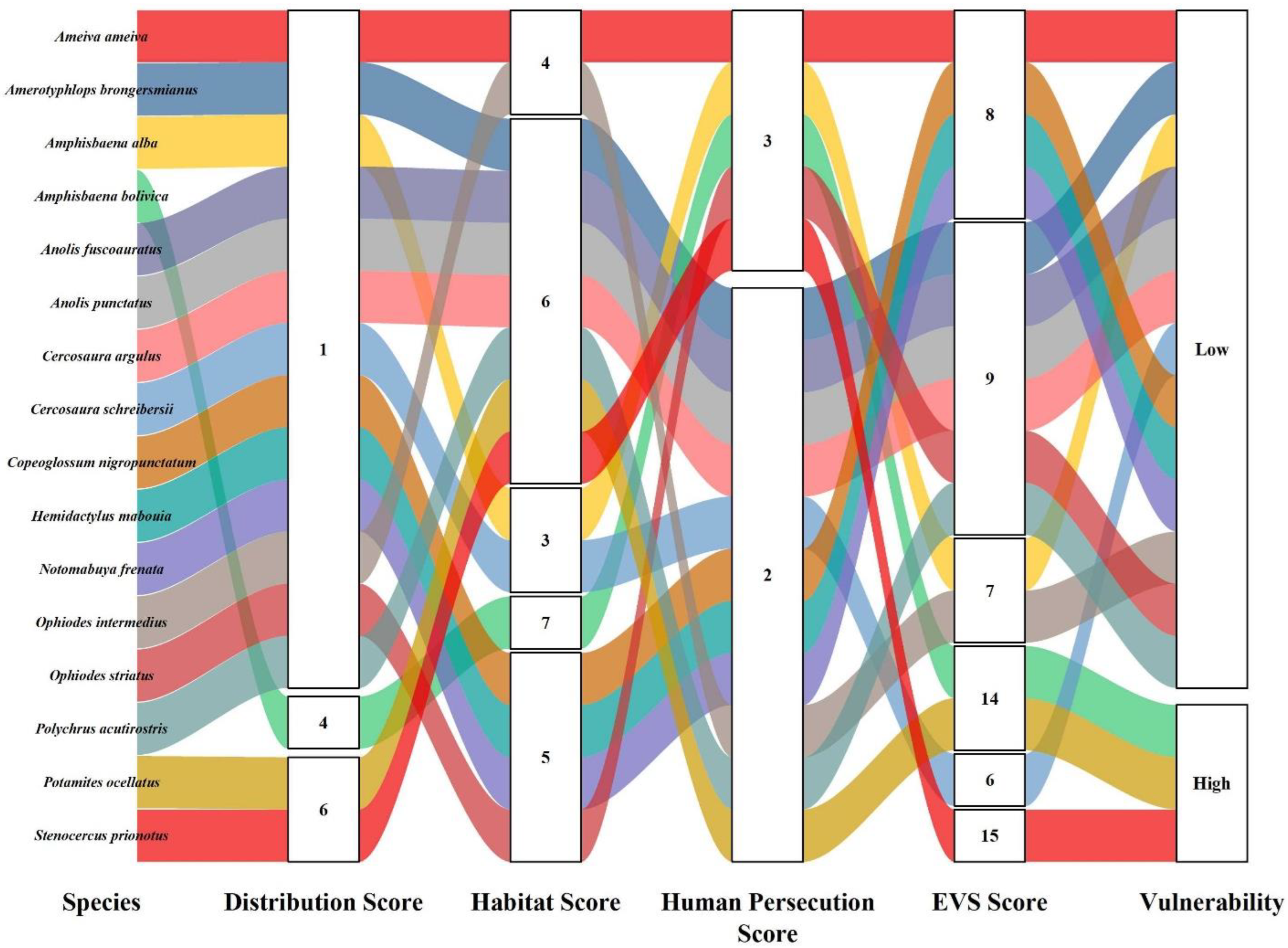
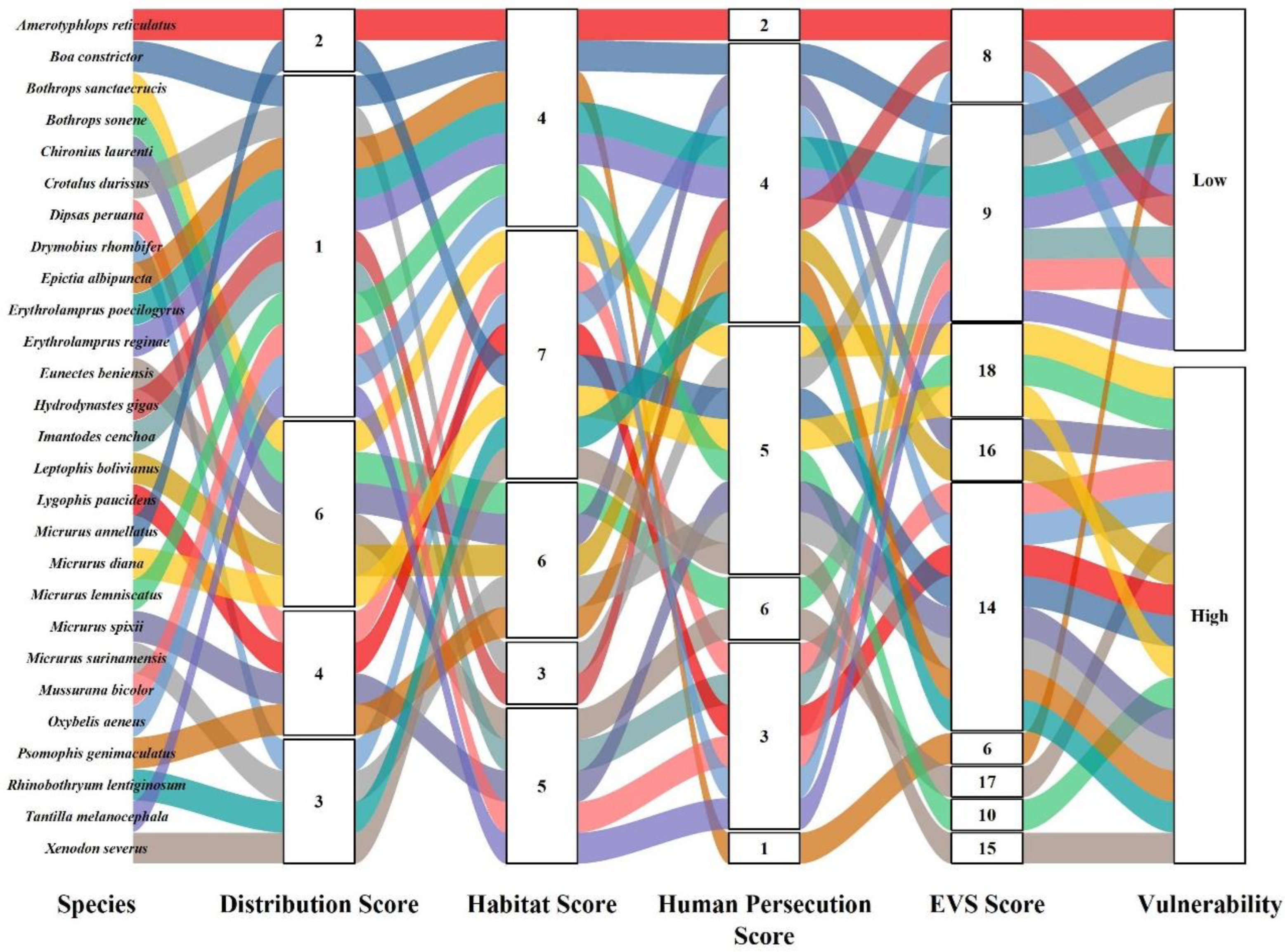
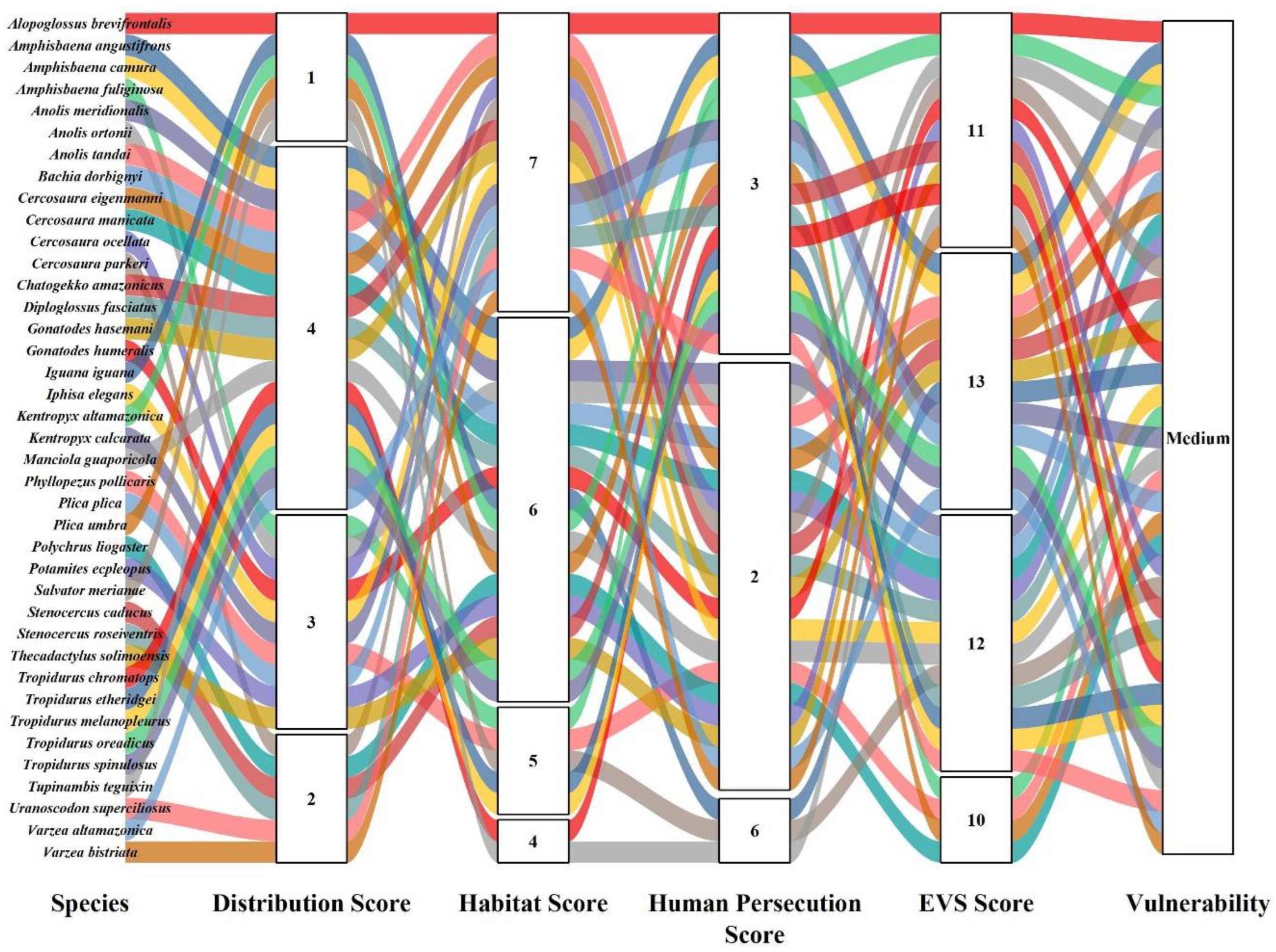
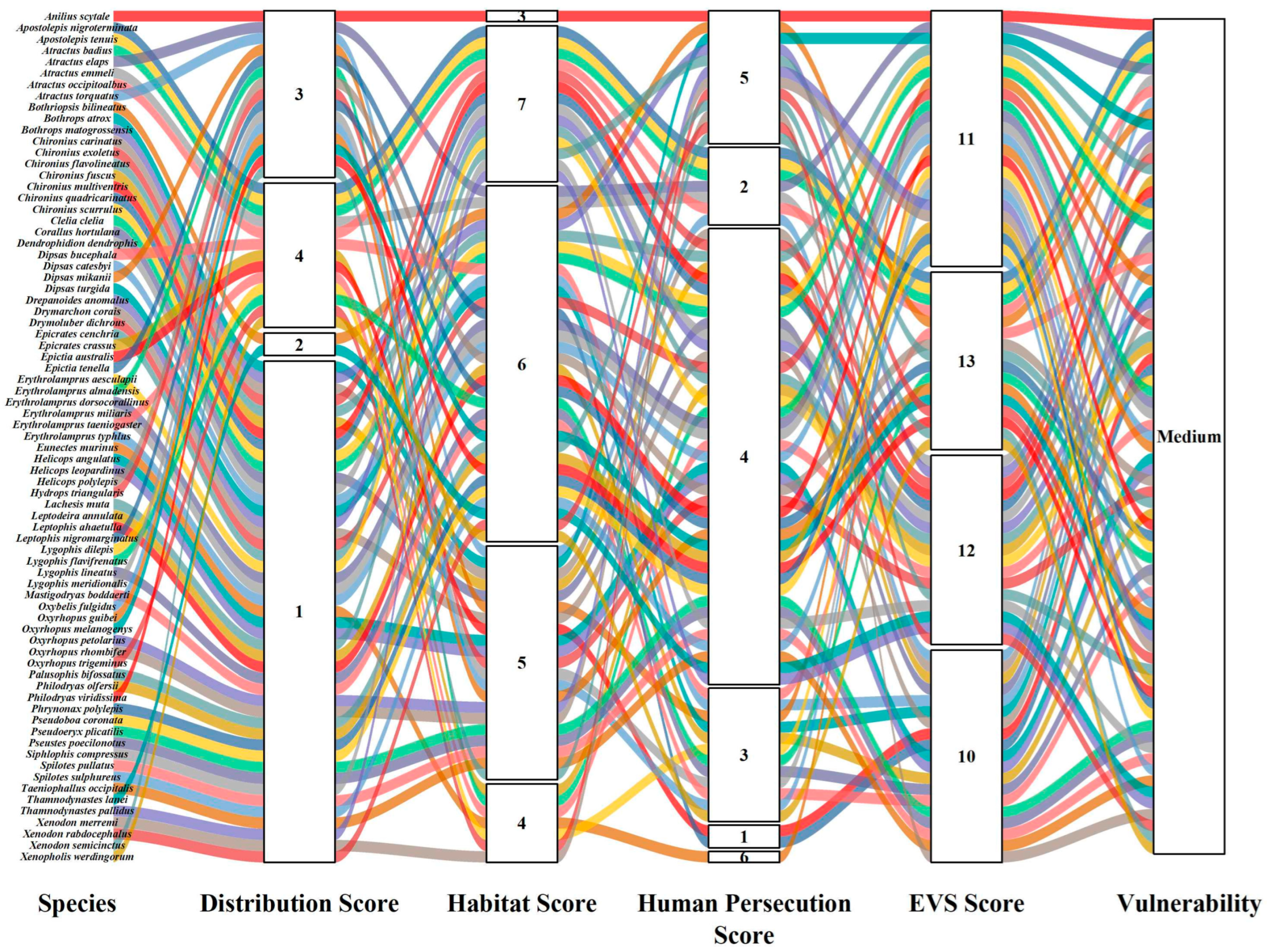
| Order | Family | Species | Authority | DS | HS | HP | EVS | Vulnerability | IUCN | Pop. Status |
|---|---|---|---|---|---|---|---|---|---|---|
| Crocodilia | Alligatoridae | Caiman crocodilus | (Linnaeus, 1758) | 1 | 7 | 6 | 14 | High | LC | Stable |
| Caiman yacare | (Daudin, 1801) | 1 | 7 | 6 | 14 | High | LC | Stable | ||
| Melanosuchus niger | (Spix, 1825) | 1 | 7 | 6 | 14 | High | LC | Unk | ||
| Paleosuchus palpebrosus | (Cuvier, 1807) | 1 | 7 | 6 | 14 | High | LC | Stable | ||
| Paleosuchus trigonatus | (Schneider, 1801) | 1 | 7 | 6 | 14 | High | LC | Stable | ||
| Squamata | Alopoglossidae | Alopoglossus brevifrontalis | (Boulenger, 1912) | 1 | 7 | 3 | 11 | Medium | LC | Unk |
| Amphisbaenidae | Amphisbaena alba | (Linnaeus, 1758) | 1 | 3 | 3 | 7 | Low | LC | Stable | |
| Amphisbaena angustifrons | Cope, 1861 | 4 | 6 | 3 | 13 | Medium | LC | Unk | ||
| Amphisbaena bolivica | (Mertens, 1929) | 4 | 7 | 3 | 14 | High | LC | Stable | ||
| Amphisbaena camura | Cope, 1862 | 4 | 6 | 3 | 13 | Medium | LC | Stable | ||
| Amphisbaena fuliginosa | (Linnaeus, 1758) | 3 | 5 | 3 | 11 | Medium | LC | Stable | ||
| Aniliidae | Anilius scytale | (Linnaeus, 1758) | 3 | 3 | 5 | 11 | Medium | LC | Stable | |
| Boidae | Boa constrictor | (Linnaeus, 1758) | 1 | 4 | 4 | 9 | Low | LC | Decreasing | |
| Corallus hortulana | (Linnaeus, 1758) | 1 | 5 | 4 | 10 | Medium | LC | Stable | ||
| Epicrates cenchria | (Linnaeus, 1758) | 1 | 7 | 4 | 12 | Medium | LC | Stable | ||
| Epicrates crassus | Cope, 1862 | 4 | 4 | 4 | 12 | Medium | LC | Unk | ||
| Eunectes beniensis | (Dirksen, 2002) | 6 | 5 | 6 | 17 | High | LC | Unk | ||
| Eunectes murinus | (Linnaeus, 1758) | 1 | 4 | 6 | 11 | Medium | LC | Unk | ||
| Colubridae | Adelphostigma occipitalis | (Jan, 1863) | 1 | 5 | 4 | 10 | Medium | LC | Stable | |
| Apostolepis nigroterminata | Boulenger, 1896 | 4 | 7 | 2 | 13 | Medium | LC | Unk | ||
| Apostolepis tenuis | Ruthven, 1927 | 4 | 7 | 2 | 13 | Medium | DD | Unk | ||
| Atractus elaps | (Günther, 1858) | 3 | 6 | 2 | 11 | Medium | LC | Unk | ||
| Atractus emmeli | (Boettger, 1888) | 4 | 6 | 2 | 12 | Medium | LC | Unk | ||
| Atractus occipitoalbus | (Jan, 1862) | 4 | 7 | 2 | 13 | Medium | NT | Unk | ||
| Atractus torquatus | (Duméril, Bibron and Duméril, 1854) | 3 | 5 | 2 | 10 | Medium | LC | Stable | ||
| Chironius carinatus | (Linnaeus, 1758) | 1 | 5 | 4 | 10 | Medium | LC | Stable | ||
| Chironius exoletus | (Linnaeus, 1758) | 1 | 7 | 4 | 12 | Medium | LC | Stable | ||
| Chironius flavolineatus | (Jan, 1863) | 1 | 6 | 4 | 11 | Medium | LC | Unk | ||
| Chironius fuscus | (Linnaeus, 1758) | 1 | 5 | 4 | 10 | Medium | LC | Stable | ||
| Chironius laurenti | (Dixon, Wiest and Cei, 1993) | 6 | 6 | 4 | 16 | High | LC | Unk | ||
| Chironius multiventris | Schmidt and Walker, 1943 | 1 | 7 | 4 | 12 | Medium | LC | Stable | ||
| Chironius quadricarinatus | (Boie, 1827) | 1 | 7 | 4 | 12 | Medium | LC | Unk | ||
| Chironius scurrulus | (Wagler, 1824) | 1 | 6 | 4 | 11 | Medium | LC | Stable | ||
| Clelia clelia | (Daudin, 1803) | 1 | 6 | 4 | 11 | Medium | LC | Stable | ||
| Dendrophidion dendrophis | (Schlegel, 1837) | 1 | 7 | 4 | 12 | Medium | LC | Stable | ||
| Dipsas bucephala | (Shaw, 1802) | 4 | 6 | 3 | 13 | Medium | LC | Unk | ||
| Dipsas catesbyi | (Sentzen, 1796) | 1 | 6 | 3 | 10 | Medium | LC | Unk | ||
| Dipsas mikanii | (Schlegel, 1837) | 3 | 5 | 3 | 11 | Medium | LC | Stable | ||
| Dipsas peruana | (Boettger, 1898) | 4 | 7 | 3 | 14 | High | LC | Stable | ||
| Dipsas turgida | (Cope, 1868) | 1 | 6 | 3 | 10 | Medium | LC | Stable | ||
| Drepanoides anomalus | (Jan, 1863) | 1 | 7 | 4 | 12 | Medium | LC | Stable | ||
| Drymarchon corais | (Boie, 1827) | 1 | 5 | 4 | 10 | Medium | LC | Stable | ||
| Drymobius rhombifer | (Günther, 1860) | 3 | 7 | 4 | 14 | High | LC | Stable | ||
| Drymoluber dichrous | (Peters, 1863) | 1 | 6 | 4 | 11 | Medium | LC | Stable | ||
| Erythrolamprus aesculapii | (Linnaeus, 1758) | 1 | 7 | 4 | 12 | Medium | LC | Stable | ||
| Erythrolamprus almadensis | (Wagler, 1824) | 3 | 4 | 4 | 11 | Medium | LC | Stable | ||
| Erythrolamprus dorsocorallinus | (Esqueda, Natera, La Marca and Ilija-Fistar, 2007) | 1 | 6 | 4 | 11 | Medium | LC | Unk | ||
| Erythrolamprus miliaris | (Linnaeus, 1758) | 1 | 6 | 4 | 11 | Medium | LC | Stable | ||
| Erythrolamprus poecilogyrus | (Wied-Neuwied, 1824) | 1 | 4 | 4 | 9 | Low | LC | Increasing | ||
| Erythrolamprus reginae | (Linnaeus, 1758) | 1 | 4 | 4 | 9 | Low | LC | Stable | ||
| Erythrolamprus taeniogaster | (Linnaeus, 1758) | 4 | 4 | 4 | 12 | Medium | LC | Stable | ||
| Erythrolamprus typhlus | (Linnaeus, 1758) | 1 | 6 | 4 | 11 | Medium | LC | Stable | ||
| Helicops angulatus | (Linnaeus, 1758) | 1 | 5 | 4 | 10 | Medium | LC | Stable | ||
| Helicops leopardinus | (Schlegel, 1837) | 1 | 5 | 4 | 10 | Medium | LC | Stable | ||
| Helicops polylepis | (Günther, 1861) | 3 | 6 | 4 | 13 | Medium | LC | Stable | ||
| Hydrodynastes gigas | (Duméril, Bibron and Duméril, 1854) | 1 | 3 | 4 | 8 | Low | LC | Stable | ||
| Hydrops triangularis | (Wagler, 1824) | 3 | 5 | 4 | 12 | Medium | LC | Stable | ||
| Imantodes cenchoa | (Linnaeus, 1758) | 1 | 5 | 3 | 9 | Low | LC | Stable | ||
| Leptodeira annulata | (Linnaeus, 1758) | 1 | 6 | 3 | 10 | Medium | LC | Stable | ||
| Leptophis ahaetulla | (Linnaeus, 1758) | 1 | 6 | 4 | 11 | Medium | LC | Stable | ||
| Leptophis bolivianus | Oliver, 1942 | 6 | 6 | 4 | 16 | High | LC | Stable | ||
| Leptophis nigromarginatus | (Gunther, 1866) | 3 | 6 | 4 | 13 | Medium | LC | Stable | ||
| Lygophis dilepis | Cope, 1862 | 4 | 4 | 3 | 11 | Medium | LC | Stable | ||
| Lygophis flavifrenatus | Cope, 1862 | 4 | 6 | 3 | 13 | Medium | LC | Stable | ||
| Lygophis lineatus | (Linnaeus, 1758) | 1 | 6 | 3 | 10 | Medium | LC | Stable | ||
| Lygophis meridionalis | (Schenkel, 1901) | 3 | 5 | 3 | 11 | Medium | LC | Unk | ||
| Lygophis paucidens * | Hoge, 1953 | 4 | 7 | 3 | 14 | High | LC | Unk | ||
| Mastigodryas boddaerti | (Sentzen, 1796) | 1 | 6 | 3 | 10 | Medium | LC | Stable | ||
| Mussurana bicolor | (Peracca, 1904) | 1 | 5 | 3 | 9 | Low | LC | Stable | ||
| Oxybelis aeneus | (Wagler, 1824) | 1 | 4 | 3 | 8 | Low | LC | Stable | ||
| Oxybelis fulgidus | (Daudin, 1803) | 3 | 5 | 3 | 11 | Medium | LC | Stable | ||
| Oxyrhopus guibei | Hoge and Romano 1977 | 3 | 5 | 4 | 13 | Medium | LC | Stable | ||
| Oxyrhopus melanogenys | (Tschudi, 1845) | 3 | 6 | 4 | 13 | Medium | LC | Stable | ||
| Oxyrhopus petolarius | (Linnaeus, 1758) | 1 | 5 | 5 | 11 | Medium | LC | Unk | ||
| Oxyrhopus rhombifer | Duméril, Bibron and Duméril, 1854 | 1 | 5 | 5 | 11 | Medium | LC | Stable | ||
| Oxyrhopus trigeminus | Duméril, Bibron and Duméril, 1854 | 4 | 4 | 5 | 13 | Medium | LC | Stable | ||
| Palusophis bifossatus | (Raddi, 1820) | 1 | 6 | 5 | 12 | Medium | LC | Unk | ||
| Philodryas olfersii | (Lichtenstein, 1823) | 1 | 6 | 4 | 11 | Medium | LC | Stable | ||
| Philodryas viridissima | (Linnaeus, 1758) | 3 | 6 | 4 | 13 | Medium | LC | Stable | ||
| Phrynonax polylepis | (Peters, 1867) | 1 | 6 | 4 | 11 | Medium | LC | Stable | ||
| Pseudoboa coronata | Schneider, 1801 | 1 | 6 | 4 | 11 | Medium | LC | Stable | ||
| Pseudoeryx plicatilis | (Linnaeus, 1758) | 1 | 5 | 4 | 10 | Medium | LC | Stable | ||
| Pseustes poecilonotus | (Günther, 1858) | 1 | 5 | 4 | 10 | Medium | LC | Stable | ||
| Psomophis genimaculatus | (Boettger, 1885) | 4 | 6 | 4 | 14 | High | LC | Stable | ||
| Rhinobothryum lentiginosum | (Scopoli, 1785) | 3 | 7 | 4 | 14 | High | LC | Stable | ||
| Siphlophis compressus | (Daudin, 1803) | 1 | 7 | 4 | 12 | Medium | LC | Stable | ||
| Spilotes pullatus | (Linnaeus, 1758) | 1 | 5 | 4 | 10 | Medium | LC | Stable | ||
| Spilotes sulphureus | (Wagler, 1824) | 1 | 6 | 4 | 11 | Medium | LC | Stable | ||
| Tantilla melanocephala | (Linnaeus, 1758) | 1 | 5 | 3 | 9 | Low | LC | Stable | ||
| Thamnodynastes lanei | Bailey, Thomas and Da Silva, 2005 | 2 | 6 | 4 | 12 | Medium | LC | Unk | ||
| Thamnodynastes pallidus | (Linnaeus, 1758) | 1 | 7 | 4 | 12 | Medium | LC | Stable | ||
| Xenodon merremi | (Wagler, 1824) | 1 | 4 | 5 | 10 | Medium | LC | Unk | ||
| Xenodon rabdocephalus | (Wied-Neuwied, 1824) | 1 | 6 | 5 | 12 | Medium | LC | Stable | ||
| Xenodon semicinctus * | (Duméril, Bibron and Duméril, 1854) | 3 | 5 | 5 | 13 | Medium | LC | Stable | ||
| Xenodon severus | (Linnaeus, 1758) | 3 | 7 | 5 | 15 | High | LC | Stable | ||
| Xenopholis werdingorum | Jansen, Álvarez and Köhler, 2009 | 4 | 6 | 3 | 13 | Medium | LC | Stable | ||
| Dactyloidae | Anolis fuscoauratus | D’Orbigny, 1837 | 1 | 6 | 2 | 9 | Low | LC | Stable | |
| Anolis meridionalis | Boettger, 1885 | 4 | 6 | 2 | 12 | Medium | LC | Stable | ||
| Anolis ortonii | Cope, 1868 | 3 | 6 | 2 | 11 | Medium | LC | Stable | ||
| Anolis punctatus | Daudin, 1802 | 1 | 6 | 2 | 9 | Low | LC | Unk | ||
| Anolis tandai * | Avila-Pires, 1995 | 4 | 7 | 2 | 13 | Medium | LC | Unk | ||
| Diploglossidae | Diploglossus fasciatus | (Gray,1831) | 4 | 6 | 2 | 12 | Medium | LC | Unk | |
| Ophiodes intermedius * | Boulenger, 1894 | 1 | 4 | 2 | 7 | Low | LC | Stable | ||
| Ophiodes striatus | Spix (1824) | 1 | 5 | 3 | 9 | Low | LC | Unk | ||
| Elapidae | Micrurus annellatus | Peters, 1871 | 2 | 7 | 5 | 14 | High | LC | Unk | |
| Micrurus diana | Roze, 1983 | 6 | 7 | 5 | 18 | High | LC | Unk | ||
| Micrurus lemniscatus | (Linnaeus, 1758) | 1 | 4 | 5 | 10 | High | LC | Decreasing | ||
| Micrurus spixii | Wagler, 1824 | 4 | 5 | 5 | 14 | High | LC | Stable | ||
| Micrurus surinamensis | (Cuvier, 1816) | 3 | 6 | 5 | 14 | High | LC | Stable | ||
| Gekkonidae | Hemidactylus mabouia | (Moreau de Jonnès, 1818) | 1 | 5 | 2 | 8 | Low | LC | Stable | |
| Gymnophthalmidae | Bachia dorbignyi | (Duméril and Bibron, 1839) | 4 | 6 | 2 | 12 | Medium | LC | Unk | |
| Cercosaura argulus | Peters, 1862 | 1 | 6 | 2 | 9 | Low | LC | Unk | ||
| Cercosaura eigenmanni * | (Griffin, 1917) | 4 | 7 | 2 | 13 | Medium | LC | Stable | ||
| Cercosaura manicata | O’Shaughnessy, 1881 | 4 | 6 | 2 | 12 | Medium | LC | Unk | ||
| Cercosaura ocellata | Wagler, 1830 | 3 | 7 | 2 | 12 | Medium | LC | Stable | ||
| Cercosaura parkeri | (Ruibal, 1952) | 2 | 7 | 2 | 11 | Medium | LC | Stable | ||
| Cercosaura schreibersii | Wiegmannnnnn, 1834 | 1 | 3 | 2 | 6 | Low | LC | Stable | ||
| Potamites ocellatus | (Sinitsin, 1930) | 6 | 6 | 2 | 14 | High | VU | Decreasing | ||
| Iphisa elegans | Gray, 1851 | 3 | 7 | 2 | 12 | Medium | LC | Stable | ||
| Potamites ecpleopus | (Cope, 1875) | 3 | 6 | 2 | 11 | Medium | LC | Unk | ||
| Iguanidae | Iguana iguana | (Linnaeus, 1758) | 1 | 6 | 6 | 13 | Medium | LC | Unk | |
| Leptotyphlopidae | Epictia albipuncta | (Burmeister, 1861) | 1 | 4 | 1 | 6 | Low | LC | Stable | |
| Epictia australis | (Freiberg and Orejas-Miranda, 1968) | 4 | 5 | 1 | 10 | Medium | LC | Stable | ||
| Epictia tenella | (Klauber, 1939) | 3 | 6 | 1 | 10 | Medium | LC | Stable | ||
| Phyllodactylidae | Phyllopezus pollicaris | (Spix, 1825) | 3 | 5 | 2 | 10 | Medium | LC | Unk | |
| Thecadactylus solimoensis | Bergmann and Russell, 2007 | 3 | 6 | 2 | 11 | Medium | LC | Stable | ||
| Polychrotidae | Polychrus acutirostris | (Spix, 1825) | 1 | 6 | 2 | 9 | Low | LC | Stable | |
| Polychrus liogaster | Boulenger, 1908 | 2 | 6 | 2 | 10 | Medium | LC | Unk | ||
| Scincidae | Copeoglossum nigropunctatum | (Spix, 1825) | 1 | 5 | 2 | 8 | Low | LC | Decreasing | |
| Manciola guaporicola | (Dunn, 1935) | 4 | 6 | 2 | 12 | Medium | LC | Decreasing | ||
| Notomabuya frenata | (Cope, 1862) | 1 | 5 | 2 | 8 | Low | LC | Stable | ||
| Varzea altamazonica | Miralles, Barrio-Amoros, Rivas, Chaparro-Auza, 2006 | 4 | 7 | 2 | 13 | Medium | LC | Unk | ||
| Varzea bistriata | (Spix, 1825) | 2 | 7 | 2 | 11 | Medium | LC | Unk | ||
| Sphaerodactylidae | Chatogekko amazonicus * | (Andersson, 1918) | 4 | 7 | 2 | 13 | Medium | LC | Stable | |
| Gonatodes hasemani | (Griffin, 1917) | 4 | 7 | 2 | 13 | Medium | LC | Stable | ||
| Gonatodes humeralis | (Guichenot, 1855) | 3 | 6 | 2 | 11 | Medium | LC | Stable | ||
| Teiidae | Ameiva ameiva | (Linnaeus, 1758) | 1 | 4 | 3 | 8 | Low | LC | Stable | |
| Kentropyx altamazonica | (Cope, 1875) | 1 | 6 | 3 | 10 | Medium | LC | Stable | ||
| Kentropyx calcarata | Spix, 1825 | 3 | 7 | 3 | 13 | Medium | LC | Stable | ||
| Salvator merianae | Duméril and Bibron, 1839 | 1 | 5 | 6 | 12 | Medium | LC | Stable | ||
| Tupinambis teguixin | (Linnaeus, 1758) | 1 | 4 | 6 | 11 | Medium | LC | Stable | ||
| Tropiduridae | Plica plica | (Linnaeus, 1758) | 3 | 7 | 3 | 13 | Medium | LC | Stable | |
| Plica umbra | (Linnaeus, 1758) | 1 | 6 | 3 | 10 | Medium | LC | Stable | ||
| Stenocercus caducus | (Copes, 1862) | 2 | 6 | 3 | 11 | Medium | LC | Stable | ||
| Stenocercus prionotus | Cadle, 2001 | 6 | 6 | 3 | 15 | High | LC | Unk | ||
| Stenocercus roseiventris | D’Orbigny in Duméril and Bibron, 1837 | 2 | 7 | 3 | 12 | Medium | LC | Stable | ||
| Tropidurus chromatops | Harvey and Gutberlet, 1998 | 4 | 4 | 3 | 11 | Medium | LC | Decreasing | ||
| Tropidurus Etheridgei * | Cei, 1982 | 4 | 5 | 3 | 12 | Medium | LC | Unk | ||
| Tropidurus melanopleurus | Boulenger, 1902 | 4 | 5 | 3 | 12 | Medium | LC | Stable | ||
| Tropidurus oreadicus * | Rodrigues, 1987 | 4 | 6 | 3 | 13 | Medium | LC | Unk | ||
| Tropidurus spinulosus | (Cope, 1862) | 4 | 6 | 3 | 13 | Medium | LC | Unk | ||
| Uranoscodon superciliosus | (Linnaeus, 1758) | 2 | 7 | 3 | 12 | Medium | LC | Stable | ||
| Typhlopidae | Amerotyphlops brongersmianus | (Vanzolini, 1976) | 1 | 6 | 2 | 9 | Low | LC | Stable | |
| Amerotyphlops reticulatus | (Linnaeus, 1758) | 2 | 4 | 2 | 8 | Low | LC | Stable | ||
| Viperidae | Bothriopsis bilineatus | (Wied-Neuwied, 1821) | 2 | 6 | 5 | 13 | Medium | LC | Stable | |
| Bothrops atrox | (Linnaeus, 1758) | 1 | 5 | 5 | 11 | Medium | LC | Stable | ||
| Bothrops matogrossensis | (Amaral, 1925) | 1 | 6 | 5 | 12 | Medium | LC | Unk | ||
| Bothrops sanctaecrucis | Hoge, 1966 | 6 | 7 | 5 | 18 | High | LC | Decreasing | ||
| Bothrops sonene | Carrasco et al. 2019 | 6 | 6 | 6 | 18 | High | NE | Unk | ||
| Crotalus durissus | (Linnaeus, 1758) | 1 | 3 | 5 | 9 | Low | LC | Unk | ||
| Lachesis muta | (Linnaeus, 1766) | 1 | 7 | 5 | 13 | Medium | LC | Unk | ||
| Testudines | Chelidae | Chelus fimbriata | (Schneider, 1783) | 3 | 7 | 6 | 16 | High | LC | Unk |
| Phrynops geoffroanus | (Schweigger, 1812) | 1 | 7 | 6 | 14 | High | LC | Unk | ||
| Platemys platycephala | (Schneider, 1792) | 3 | 7 | 6 | 16 | High | LC | Unk | ||
| Kinosternidae | Kinosternon scorpioides | (Linnaeus, 1766) | 1 | 7 | 6 | 14 | High | LC | Stable | |
| Podocnemididae | Podocnemis expansa | (Schweigger, 1812) | 1 | 7 | 6 | 14 | High | LC | Unk | |
| Podocnemis unifilis | (Troschel, 1848) | 1 | 7 | 6 | 14 | High | VU | Unk | ||
| Testudinidae | Chelonoidis carbonaria | (Spix, 1824) | 1 | 5 | 6 | 12 | Medium | NE | Unk | |
| Chelonoidis denticulatus | (Linnaeus, 1766) | 1 | 5 | 6 | 12 | Medium | VU | Unk |
Disclaimer/Publisher’s Note: The statements, opinions and data contained in all publications are solely those of the individual author(s) and contributor(s) and not of MDPI and/or the editor(s). MDPI and/or the editor(s) disclaim responsibility for any injury to people or property resulting from any ideas, methods, instructions or products referred to in the content. |
© 2024 by the authors. Licensee MDPI, Basel, Switzerland. This article is an open access article distributed under the terms and conditions of the Creative Commons Attribution (CC BY) license (https://creativecommons.org/licenses/by/4.0/).
Share and Cite
Eversole, C.B.; Powell, R.L.; Rivas, L.R.; Lizarro, D.E. Reptile Biodiversity and Vulnerability in Bolivia’s Beni Department: Informing Conservation Priorities in a Neglected Frontier. Diversity 2024, 16, 335. https://doi.org/10.3390/d16060335
Eversole CB, Powell RL, Rivas LR, Lizarro DE. Reptile Biodiversity and Vulnerability in Bolivia’s Beni Department: Informing Conservation Priorities in a Neglected Frontier. Diversity. 2024; 16(6):335. https://doi.org/10.3390/d16060335
Chicago/Turabian StyleEversole, Cord B., Randy L. Powell, Luis R. Rivas, and Dennis E. Lizarro. 2024. "Reptile Biodiversity and Vulnerability in Bolivia’s Beni Department: Informing Conservation Priorities in a Neglected Frontier" Diversity 16, no. 6: 335. https://doi.org/10.3390/d16060335
APA StyleEversole, C. B., Powell, R. L., Rivas, L. R., & Lizarro, D. E. (2024). Reptile Biodiversity and Vulnerability in Bolivia’s Beni Department: Informing Conservation Priorities in a Neglected Frontier. Diversity, 16(6), 335. https://doi.org/10.3390/d16060335







